 Noodle: 1.noun: dough rolled into thin, flat strips; pasta 2.verb: “to noodle”; a primative method of putting food on the table, specifically catfish, involving a hapless fish, a soaked human, no fishing pole and two brains of equal size. Also known as “grabblin”, “hoggin”, “doggin”, “gravelin’ or “ticklin”. Ever heard of “noodling”? From the National Geographic: “Some people call it the Mount Everest of fishing. But most everyone else describes “noodling” or handfishing, as just plain crazy” The Oxford English Dictionary defines “noodling” as “a stupid person”. Hmmm. Think about that. The sport with the same name requires walking along a riverbank, in the water – no – sometimes under the water, feeling for a fish in places where beavers, snakes and snapping turtles are just as likely to hide and then putting one’s hand into the fish’s mouth where tender skin is no match for razor-like teeth. I might call that less than brilliant! While noodling is carried out in most parts of the South, here in Oklahoma, we are proud of those who noodle and we hold up Pauls Valley as the home of the Olympics of noodling – the annual Okie Noodling Tournament. Bob’s Pig Shop is the sponsor, with live entertainment and fried catfish making for a fun festival atmosphere. This year’s gathering of the bold and the brave happens on July 10th. I grew up with stories about my father’s, my grandfather’s and my great-grandfather’s “noodlin’ ” adventures. My dad shares in his book, Sailing Down the River of Memories, his noodling expertise which was handed down through the generations to him. We are very big on passing on traditions in my family, however, somehow this tradition of risking life and limb and appendages seems to have stopped with my father. Go figure. On page 17 Dad shares: “I learned to noodle or to fish with my hands. Now, that was an adventure! I’d go into the water and feel along the bank until I found a hole. Then, I’d slowly reach in to see if there might be a fish. Interestingly enough, by moving slowly and being gentle, you can stroke a fish under water and it won’t swim off. I’d carefully put a finger in the mouth and the thumb in the gill and bring the fish up close to my body. Then I put my other hand on the body of the fish so it couldn’t get away and I’d walk out of the water. The adventure was the chance of getting a turtle or a snake – but I never did. You had to be careful with catfish because the whiskers could stick in your skin and really hurt.” Dad also tells about his granddad, my great-granddad – Robert Hightower, who taught him how to finesse a catfish. “One of the largest fish he noodled was a 28-pound catfish on Spring River at Galesburg. [Missouri] Since that was not a legal way of fishing, Bob told everyone he had landed it with a cane pole. His description of the battle was so vivid no one doubted his word, but the scratches on his arms and fingers told another tale. He told son-in-law, Charlie [my granddad], he threaded a cord through the catfish’s mouth and gill and after tying the other end around his arm, he started for the bank. Something startled the fish and it went downstream pulling him with it. He had quite a battle getting to shore and landing the fish. When he put the fish on a 300 lb cake of ice, its head was at one end with the tail hanging over the other end nearly touching the ground.” Robert Hightower is featured in the Then and Now Cookbook I hope you enjoy this video that shows that men “ain’t got nuthin’ on us females” when it comes to noodlin’…………… OK, so that same side of my family, in spite of the obvious quirky side passed down through the generations to me, I was handed down another kind of “noodlin'”- the homemade kind. I was raised on Sunday lunch that included either chuck roast cooked to perfection, shredding to moist strips, or chicken equally moist and falling off the bone. Both were accompanied by homemade noodles gently boiled in the broth from the meats. Before we would leave for church, Mom would put the meat, onions and salt and pepper into a dutch oven with water and would leave it to bake slowly while we were gone. When we walked into the house after a morning of worship, the aroma would be so permeating that the saliva glands had an immediate Pavlovian response. Dad always made the noodles and he did it just as his mother had taught him. His great-aunt Myrtle, Grandmother’s sister, taught Grandmother how to make them and then, my father taught me. Dad can cut those noodles so thin that the result is delicate and tender. He still makes them when we go home and now, the next generation has taken its place as my children are now making the noodles in their homes. Below is the photo recipe for one of our favorite family traditions. I hope you enjoy them as well. Since I never learned to practice the other “noodlin'”, I’m satisfied with my efforts at the pasta variety. However, if you want to take up the sport, more power to you – and to the fish. 1 cup flour 1 large egg Approximately 3 tbsp water 6 cups broth – either chicken or beef 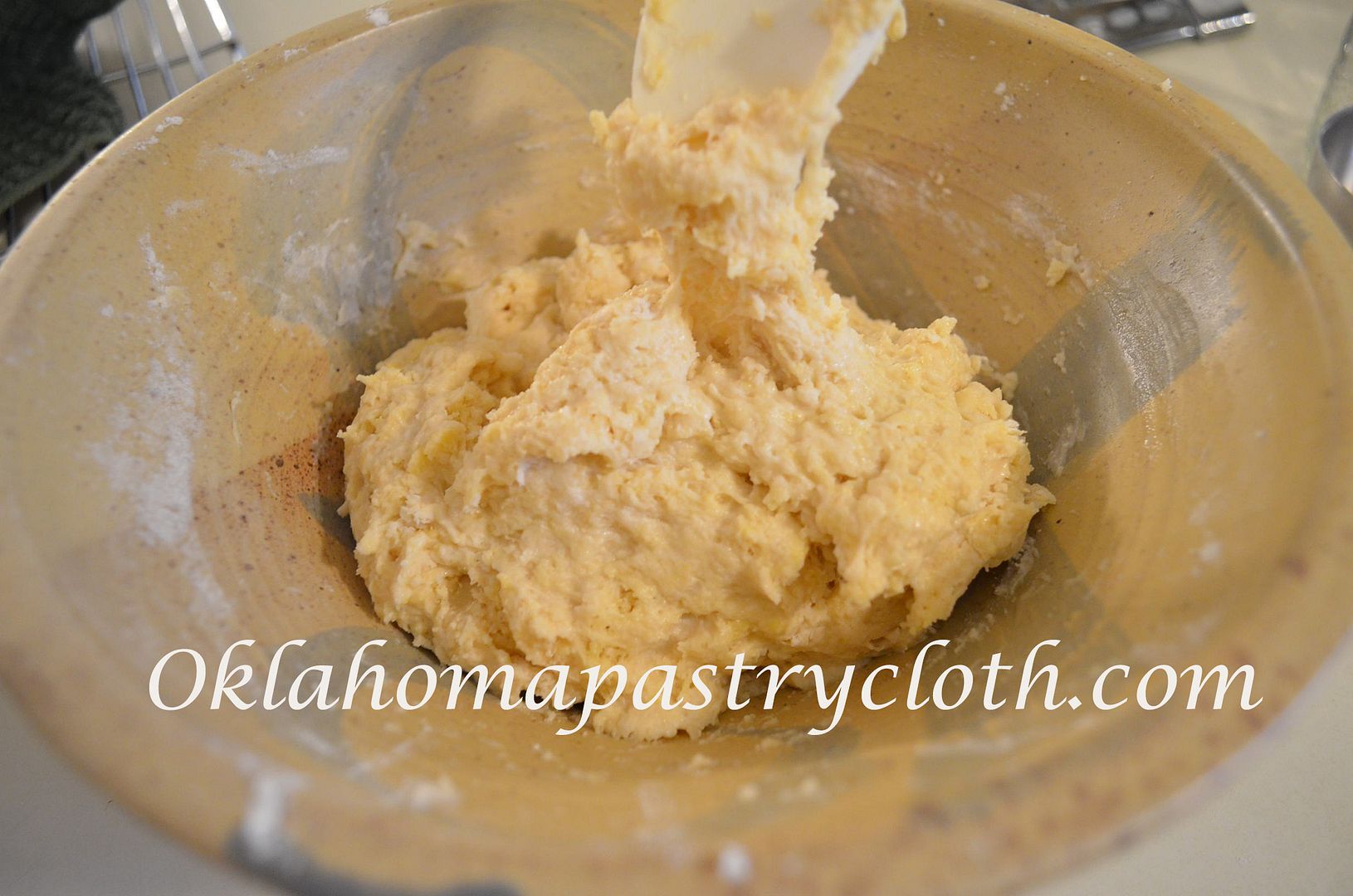 Put flour into a bowl and make a well in the center. Break the egg into the center and scramble. Add enough water to make a sticky dough. My dad always said that Grandmother taught to use a large egg, broken at the small end toward the top and then use the larger end filled with water. However, it is my opinion that chickens must have been larger back in those days and so I use 2-3 egg shell measures of water. (about 3 tbsp) 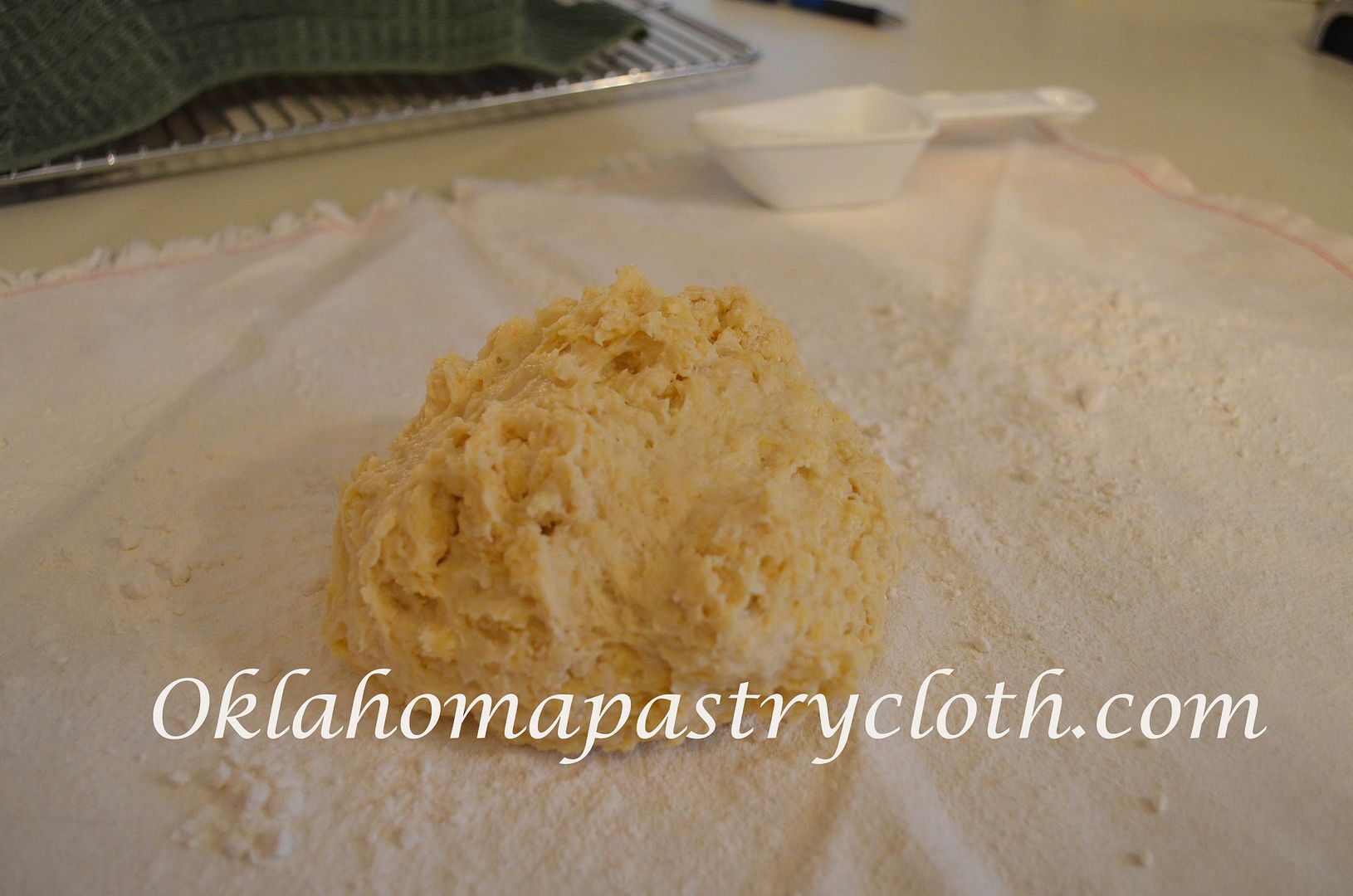 Pour the dough out onto a floured Oklahoma Pastry Cloth™ and knead in just enough flour so that it can be handled easily  Gently flour the outside of the dough and roll it around until it forms a ball 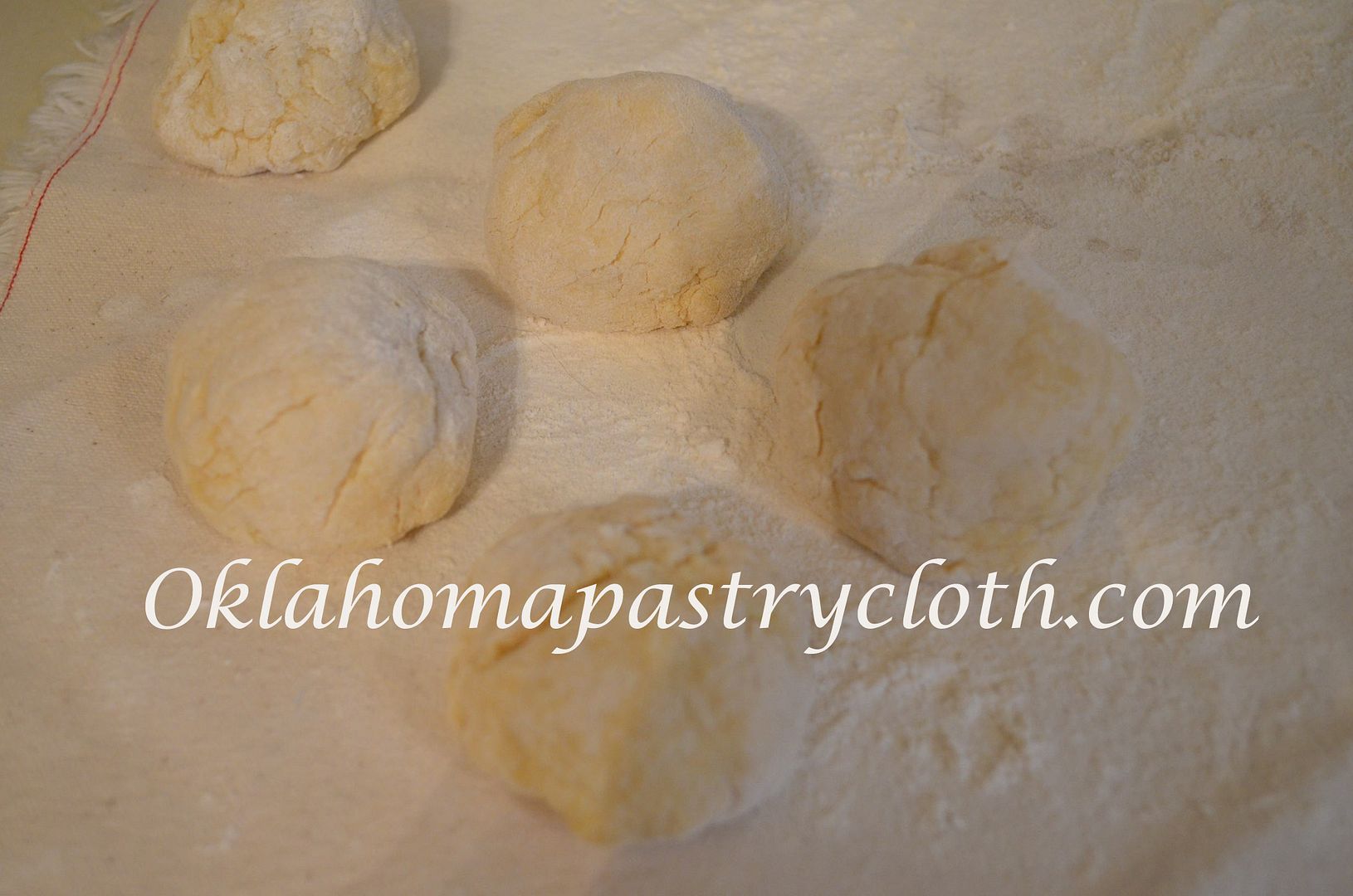 Divide the dough into 4-6 pieces and roll them into smaller balls. 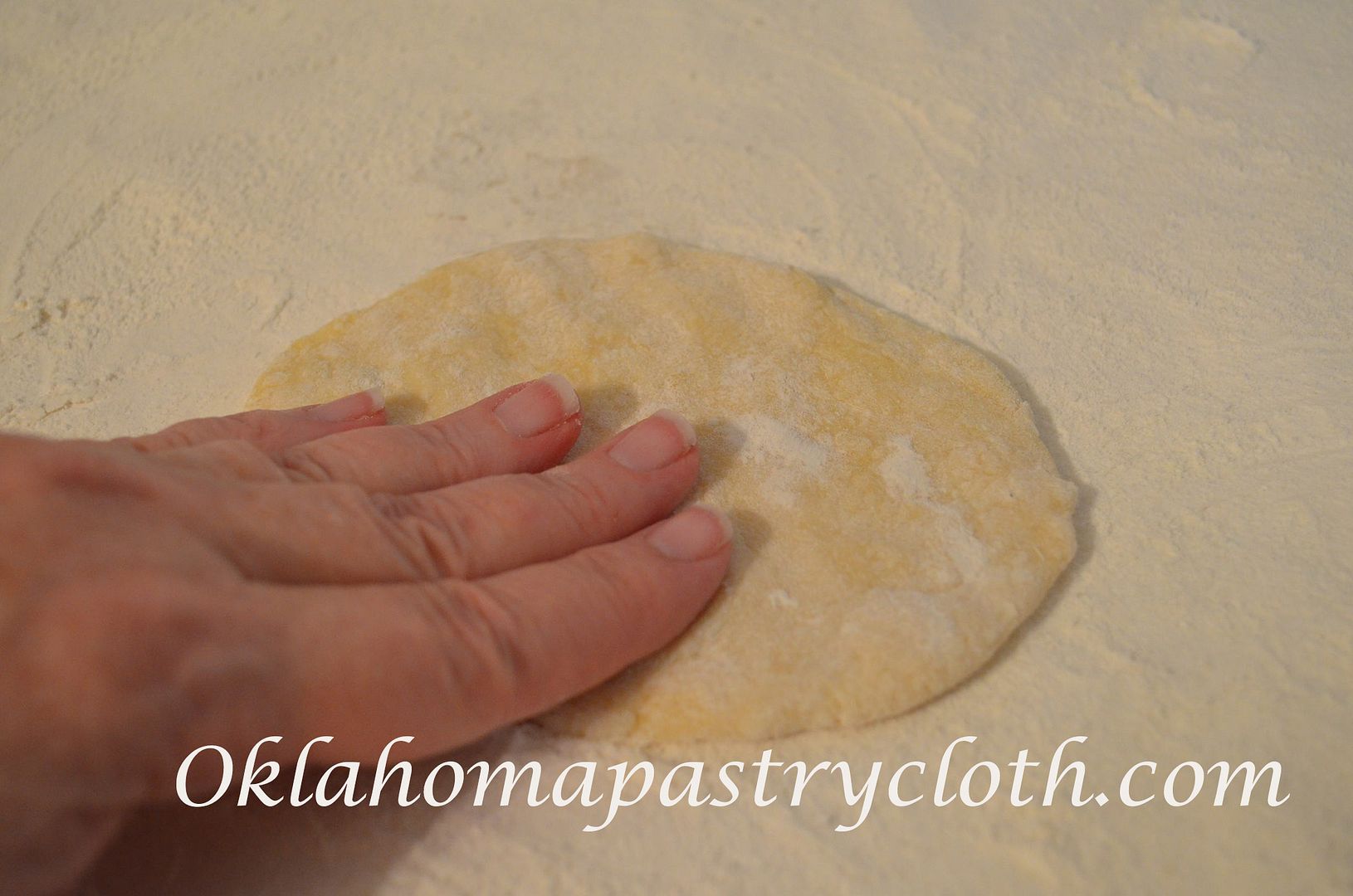 Using one dough ball at a time, pat into a circle with your hand. 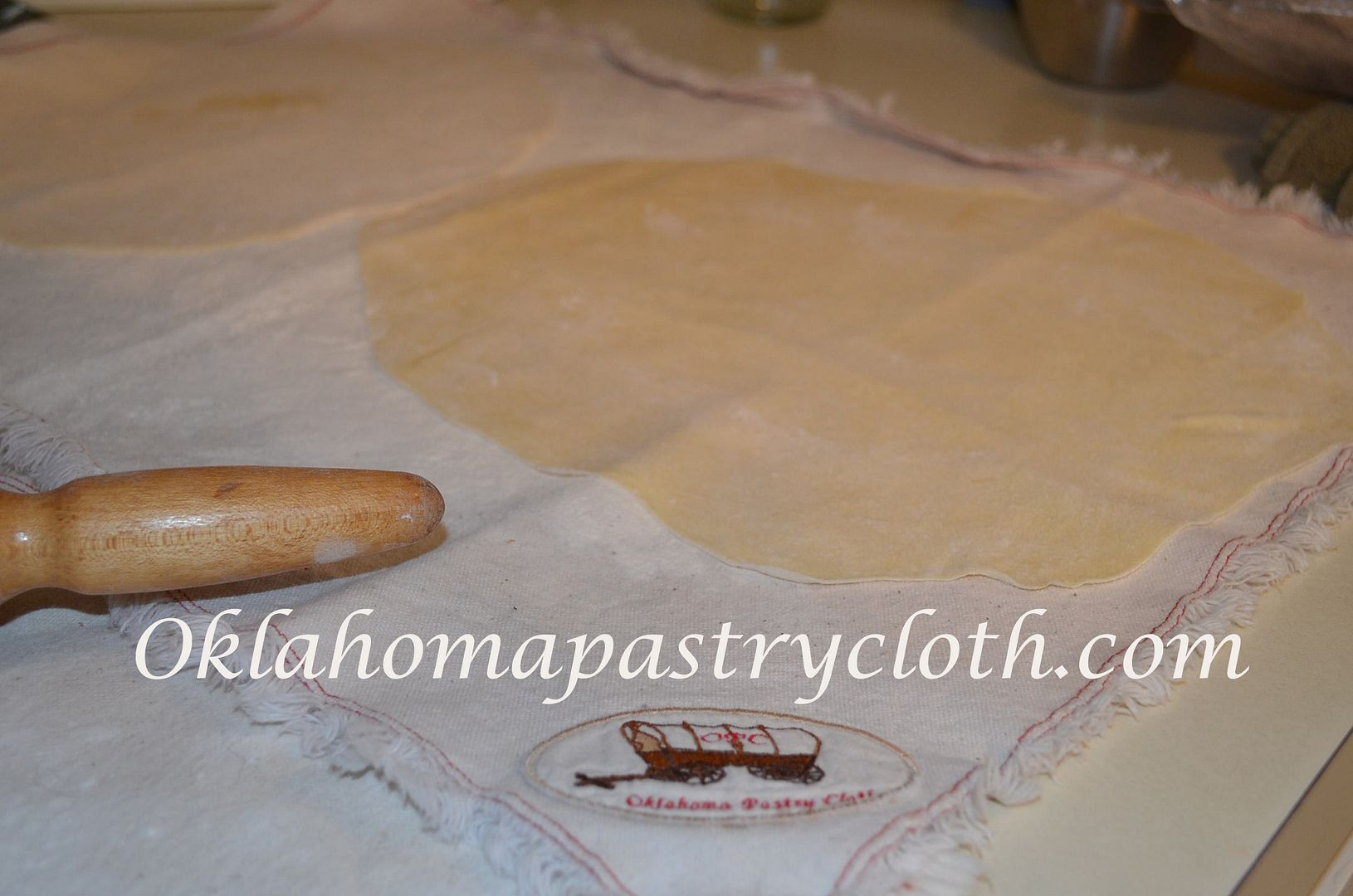 Using a rolling pin, roll the circle out to very, very thin, turning frequently and sprinkling with flour to avoid sticking. Always keep plenty of flour on the pastry cloth. Gently lift flattened circles, as they are completed, and place them on a cookie rack or floured surface such as a counter top, cutting board, a second pastry cloth or a tea towel for drying. Allow to dry at least 30 minutes on each side. If the air is moist, it can take longer. Repeat the process on remaining dough balls.
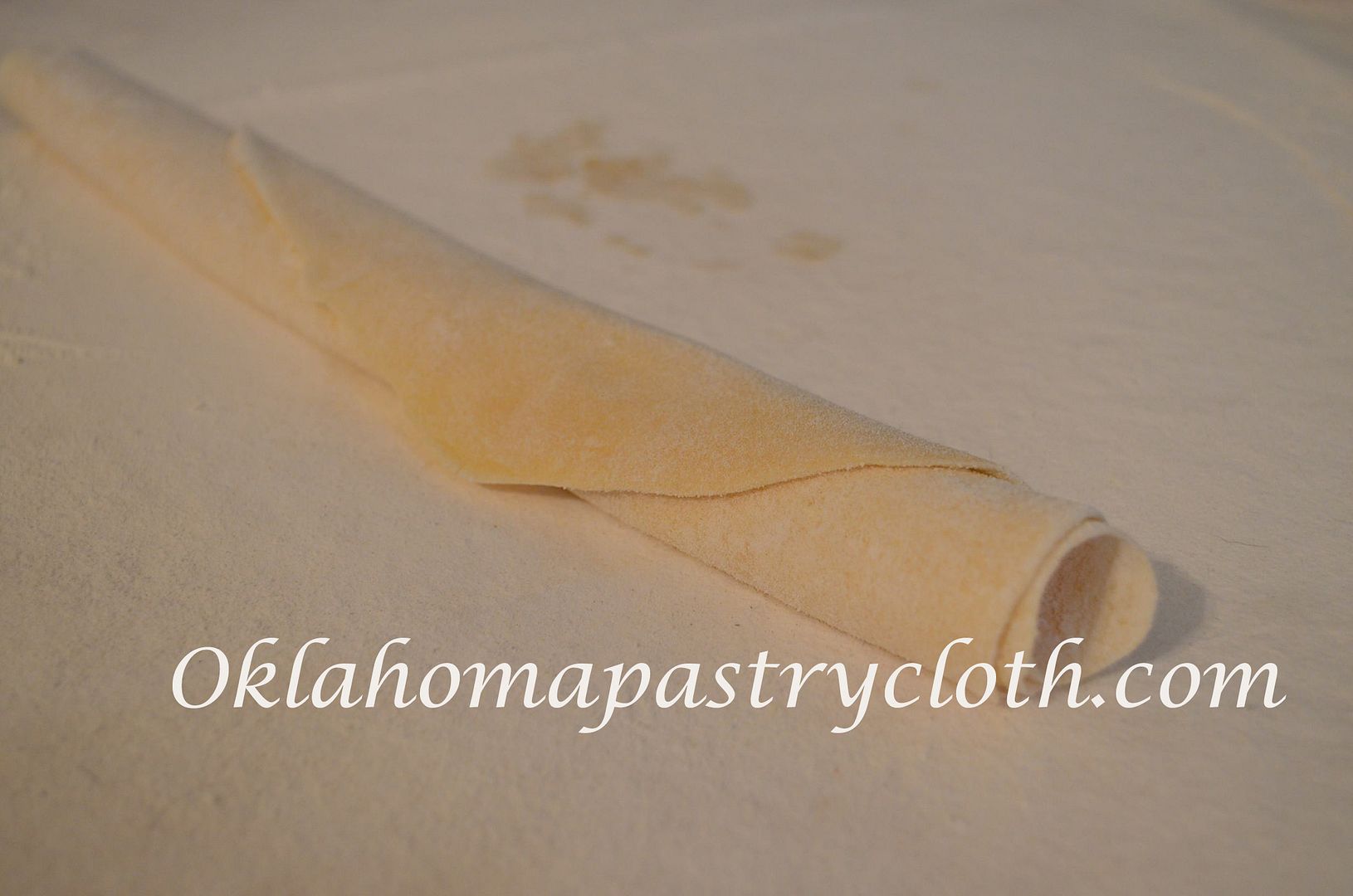 When the circles of dough are dry, but still very pliable, roll each one into a very loose jelly roll. Before rolling, you can flour the surface lightly to keep from sticking 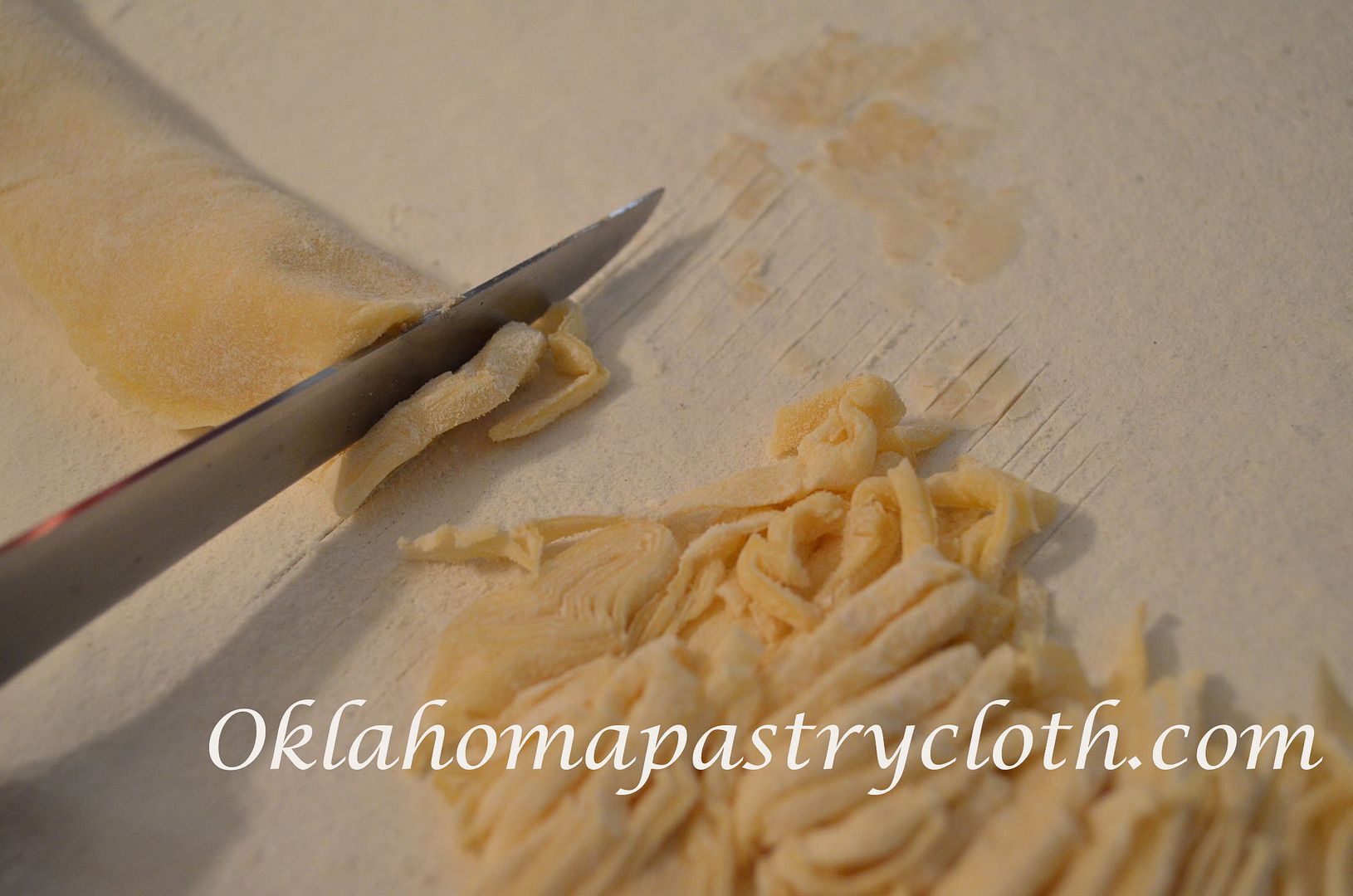 With a good, sharp knife, slice noodles thinly and then run fingers through them to loosen, unroll and separate. Be careful not to pinch the dough as you are cutting, just holding it lightly between thumb and finger  The noodles can sit in the open air while you prepare your broth. Bring broth to a boil. Reduce heat slightly and gently drop noodles in a handful at a time, stirring lightly with a fork. Cook approximately 15 minutes until tender. You can add canned broth if more broth is needed. Serve immediately over meat (baked or boiled chicken or beef) or mashed potatoes or as a side.  Now that’s the way to use the ol’ noodle!!  |
|
| |
|
Oklahoma Pastry Cloth™ Company on Facebook
|
|
 |
|
|
|
Archive for the ‘Vegetables and Side Dishes’ Category
Homemade Noodles and Noodlin’
Saturday, February 27th, 2010
Peter Piper, Pickled Peppers Aren’t Picked Pickled
Tuesday, September 8th, 2009A History Lesson on Peppers and A Photo Session/Recipe on Pickling Peppers
“Peter Piper picked a peck of pickled peppers.” This child’s poem seems to have first appeared in Peter Piper’s Practical Principles of Plain and Perfect Pronunciation” by John Harris in England in 1813. The little book included a tongue twister for every letter of the alphabet. However, according to The Oxford Companion to Childrens Literature by H. Carpenter and M. Prichard, the Peter Piper poem was actually recited for many years before the publication of the book.
The preface to Harris’ book is pretty funny. It reads: Peter Piper, without Pretension to Precocity or Profoundness, Puts Pen to Paper to Produce these Puzzling Pages, Purposely to Please the Palates of Pretty Prattling Playfellows, Proudly Presuming that with Proper Penetration it will Probably, and Perhaps Positively, Prove a Peculiarly Pleasant and Profitable Path to Proper, Plain and Precise Pronunciation. He Prays Parents to Purchase this Playful Performance, Partly to Pay him for his Patience and Pains; Partly to Provide for the Printers and Publishers; but Principally to Prevent the Pernicious Prevalence of Perverse Pronunciation.
And speaking of peppers, they are a wonderful and useful addition to any garden. We always include a variety of bell peppers, banana peppers and jalapenos. When I am in the mood for hotter peppers, I include habeneros as well.
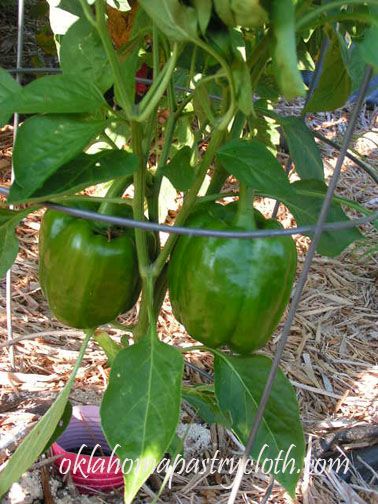
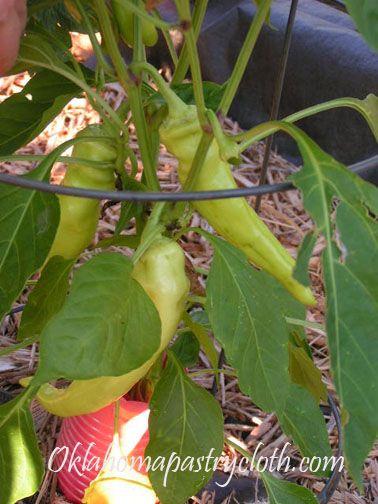
Peppers are a member of the nightshade family of plants which include potatoes, tomatoes, eggplant and tobacco of all things! The Nightshade plant, itself a member of the family, is deadly. It looks like a miniature tomato plant. The peppers are of the species Capsicum and contain capsaicin which is a chemical that produces a burning sensation in the mouth, the skin and the digestive tract. It keeps animals from eating the peppers, but doesn’t seem to bother birds which then spread the seeds. Capsaicin is used in medicine as a pain reliever and to stimulate circulation.
Peppers are native to Central and South America and were taken to Spain in 1493. Their use and cultivation then spread to Europe and Asia. Supposedly, Christopher Columbus misnamed them “peppers” or pimento in Spanish because peppercorns were so valuable and he mistakenly thought the peppers were of the same family. He seemed full of mistaken assumptions!! Wrong continent and wrong plants.
One interesting name that I have heard my Missourian father use in reference to bell peppers is “mango”. This label for peppers is also used in parts of Kentucky, Ohio and Pennsylvania. But since the real mango fruit has become so popular, this old term for peppers is fading.
(thanks to the New World Encyclopedia!)
We pickle peppers at our home every year. However, we use a whole different approach. I took my grandmother’s recipe for bread and butter pickles, tweaked it a bit and have come up with my own recipe for “Sweet-Hot Peppers”. You can find my grandmother’s pickle recipe in the cookbook for sale on the shopping page.
Following is a photo instruction and recipe for my “Sweet-Hot Peppers.”
Ingredients:
4 quarts of bell, banana and jalapeno peppers. The ratio of jalapenos to the other peppers will determine how hot your relish will be. Your choice. Also, I throw in a few jalapenos that have turned red or a red bell pepper to add color.
6 medium white or yellow onions
1/3 cup non-iodized salt or canning salt
3 cups white vinegar (5%)
4 1/2 cups sugar
1 1/2 tsp tumeric powder
1 tsp celery seed
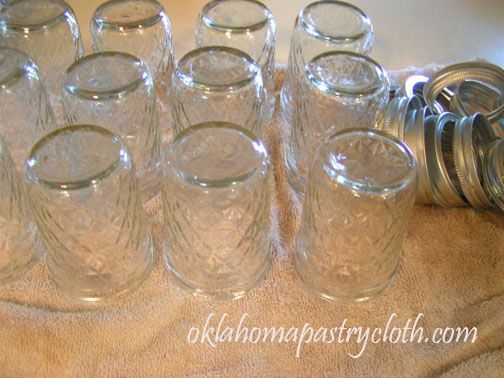
Wash and dry jars and rings. Boil lids and turn down heat to very low to keep the lids warm.
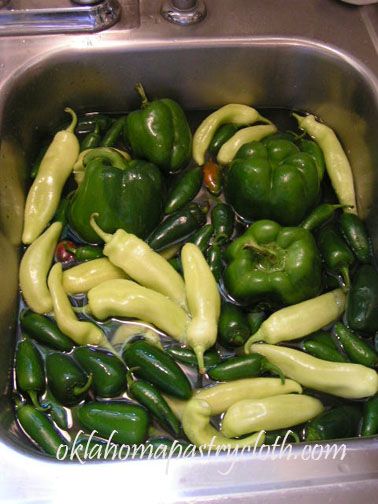
Wash peppers

Core, seed and chop bell peppers into small pieces.
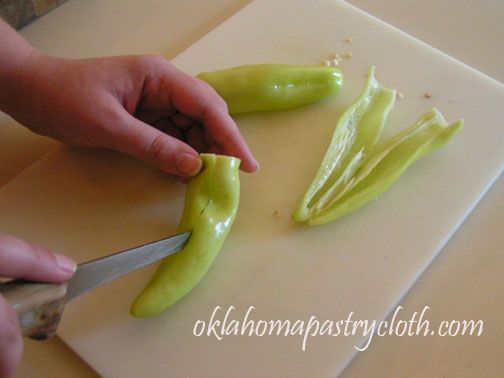
Slice banana peppers down the center of one side. Lift out seeds and discard and chop into thin strips.
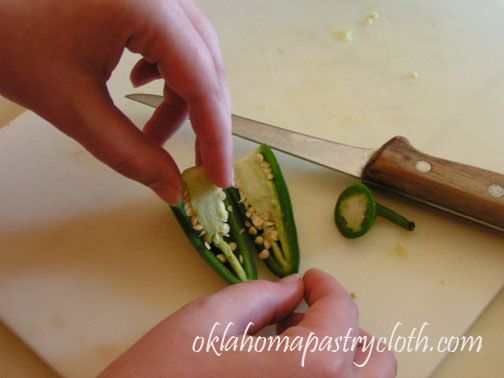
Slice jalapenos in half. Lift out seeds and discard and slice peppers into pieces or half rings. You may require rubber gloves to keep fingers from burning and to help you avoid accidently rubbing the capsaicin in your eyes or nose.
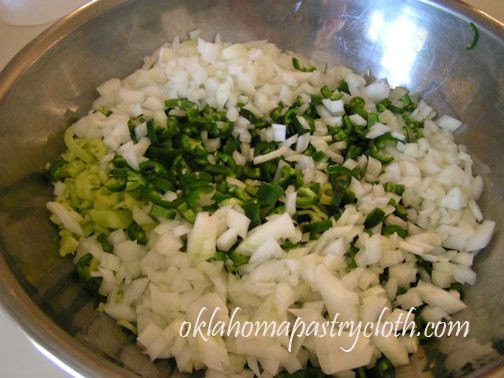
Chop onions into small pieces and put all peppers with onions into a large stainless steel or glass bowl.
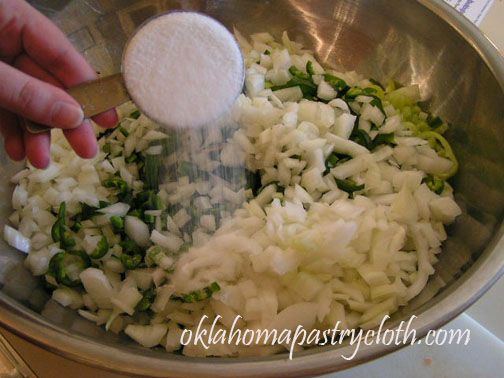
Sprinkle 1/3 cup non-iodized salt over the vegetables
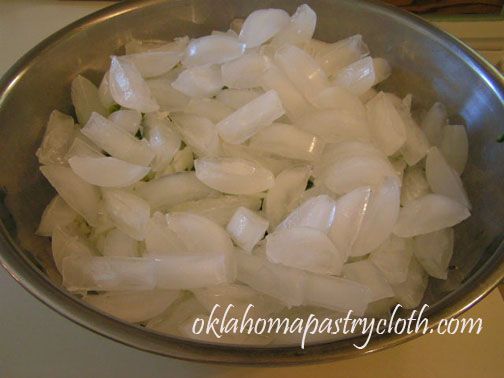
Cover with plenty of ice cubes.
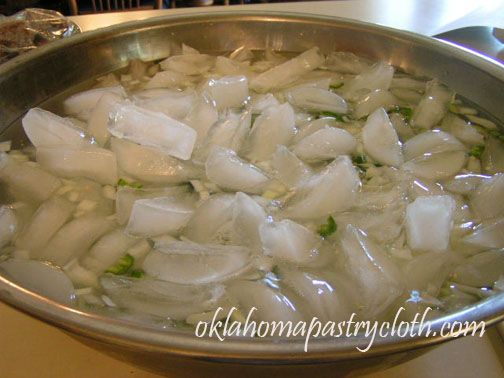
Add water to cover all of the vegetables and let sit for 3 hours. After 3 hours, remove any remaining ice cubes and drain off all water. DO NOT RINSE vegetables.
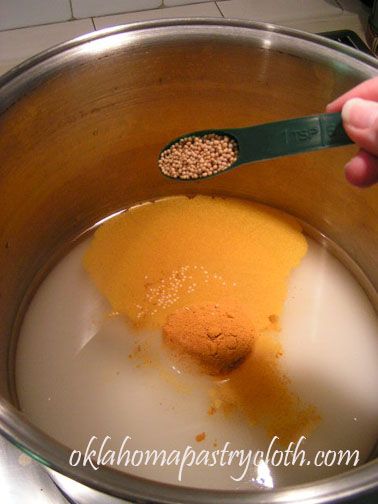
In a large stock pot, pour in vinegar, add sugar and stir in tumeric, mustard seed and celery seed.
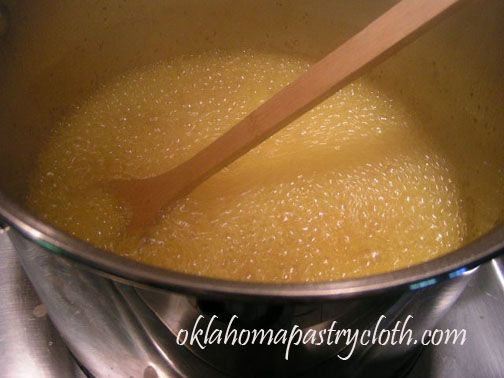
Stirring, bring to a rolling boil.
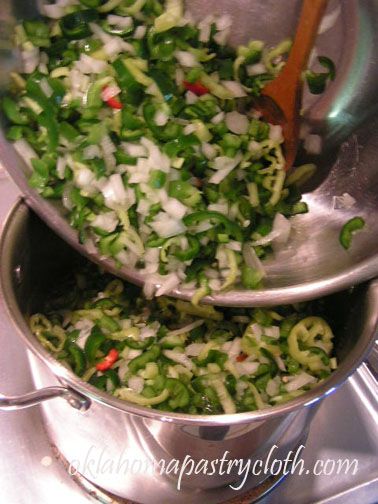
Pour vegetables into boiling syrup and turn off heat.
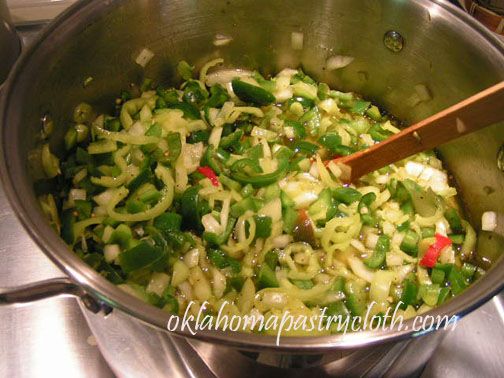
Stir to coat all vegetables and remove pot from burner. Because peppers are more delicate than cucumbers, you do not want to heat them too much like bread and butter pickles. You want the peppers to be more raw and crisp.
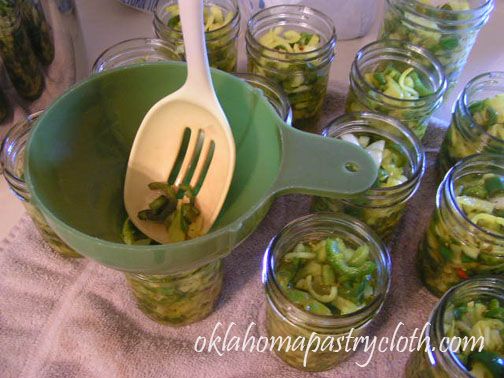
Immediately spoon pepper mix into jars to 1/2 inch from top. Pack in as much of the vegetable mixture as possible. You can add more liquid later.
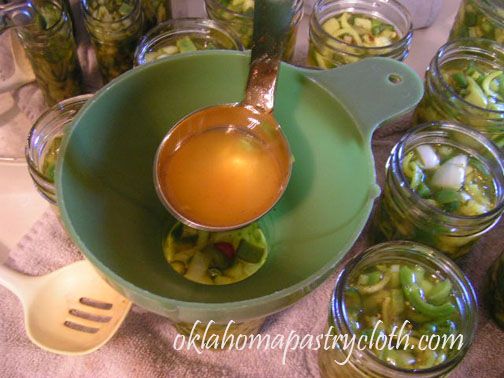
Add leftover liquid to 1/2″ from top.
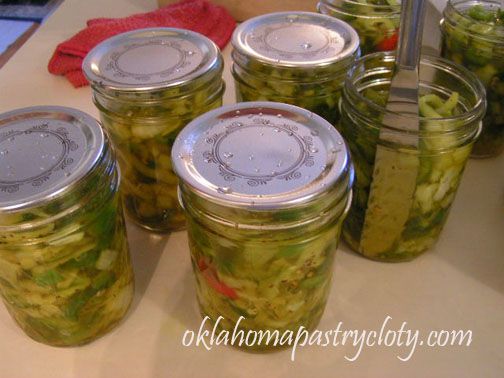
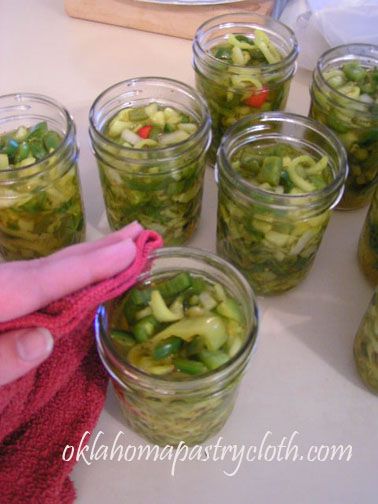
Using a knife, run around the inside perimeter of the jars to release any air bubbles. With a damp cloth, wipe the edges of the jars to remove any sticky residue. Add lids and rings and tighten rings but not too tight.
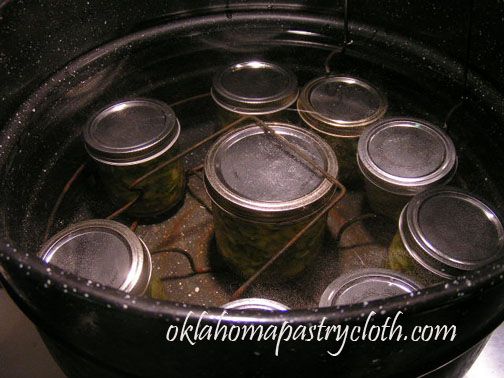
Place jars into waterbath cannner and cover jars with water, 1 inch over the tops of the lids. Bring to a boil and process for 10 minutes and no more. Remove from canner and allow to cool. Wash and label.
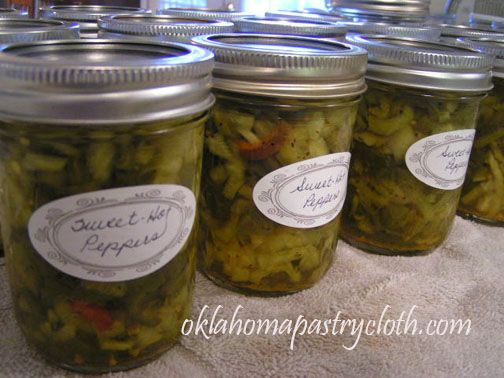
Now you are ready for pepper gifts and a wonderful condiment for your scrambled eggs, sandwiches, pinto beans, soups and anything else you can think of!!
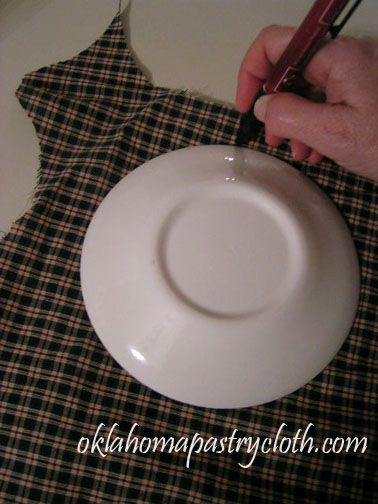
To make your gift jar, use any kind of cotton material and draw a circle using a small saucer as a guide.
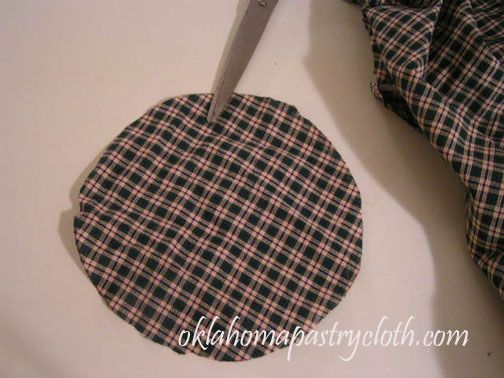
Cut the cloth circle from the fabric
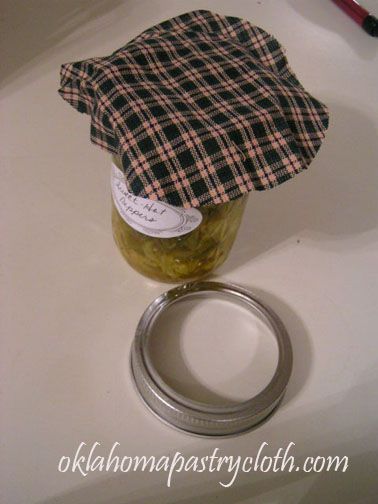
Remove the ring from the jar and place the cloth circle on top. Replace ring and tighten.
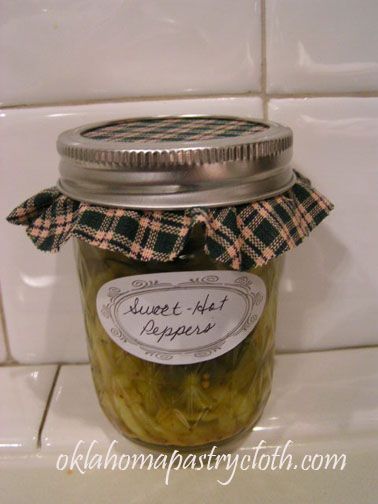
There you go!!
All That Flowers is Not Hibiscus
Wednesday, August 26th, 2009
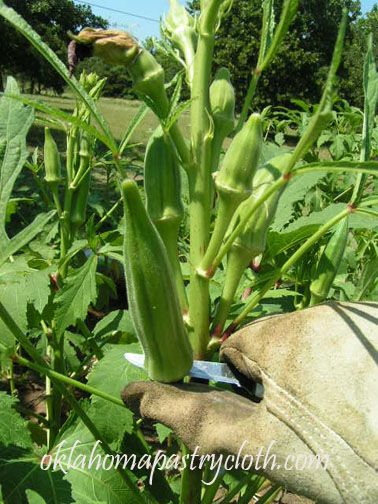
Cutting okra requires gloves and a long-sleeved shirt.
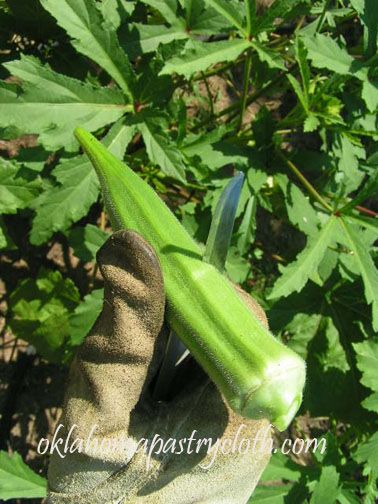
To test for toughness, make a slight cut into the pod. The knife should easily slice through the surface.
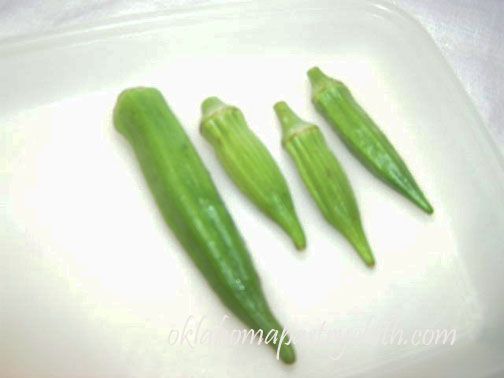
The okra pods will be various sizes and you can separate them according to the sizes for particular cooking methods. The smaller pods are great for boiled okra with butter and salt. The medium sizes are great for pickling and all sizes are suitable for frying and soups.
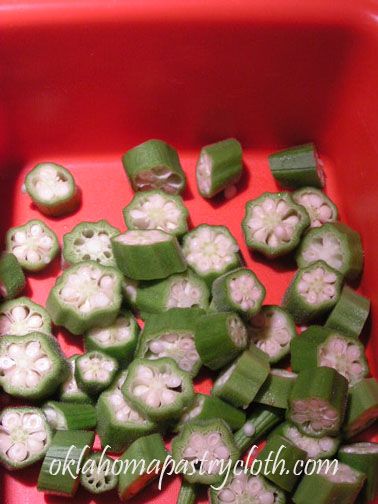
To freeze your okra for frying, cut the pods into bite sized pieces and place into a deep container that can be covered.
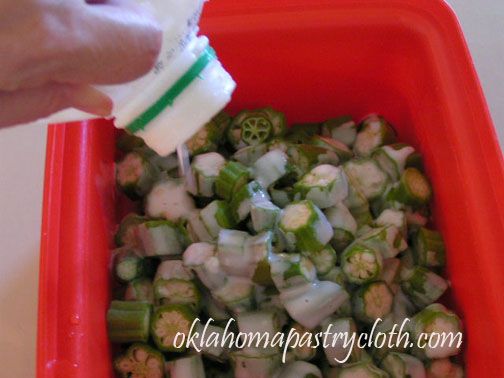
Add enough milk to the container to coat the pieces. I like to use buttermilk. Don’t worry about using too much, because you can drain off any excess.
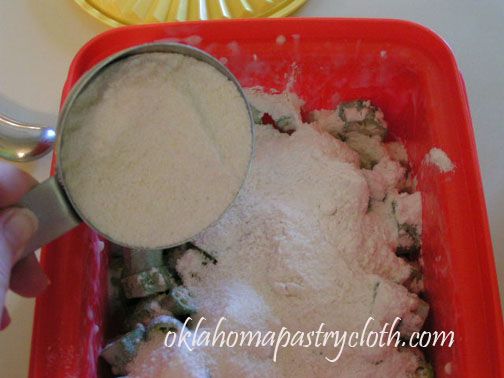
Next, add half a cup of flour and a half a cup of cornmeal. Cover the container and shake to coat the okra pieces.

This okra needs more covering so I will add equal amounts of more flour and cornmeal. I do not add salt until after I have cooked okra because salt can make the crust tough.
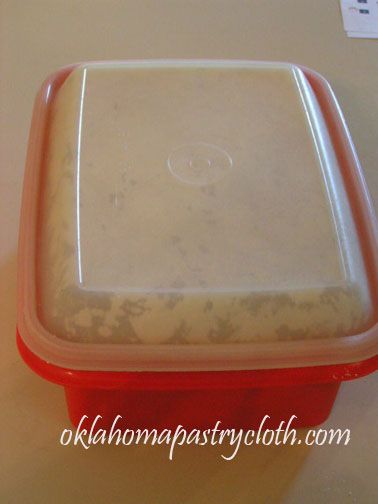

Cover and shake again. This okra is adequately coated.
Pour okra into shallow cake pans for small freezers, or onto cookie sheets for larger freezers and spread evenly over the surface. Freeze.
When the okra is frozen hard, using hands or slotted spoon, sift frozen okra and place into freezer bags and label. Freeze leftover coating for future okra.
Uncoated okra can be frozen the same way for soups and for the recipe that follows. Do not pre-scald okra to freeze, but just freeze it fresh off the stalk. Placing the pieces on a shallow dish to pre-freeze makes it easy to take out only the amount that you wish to use for each meal. The pieces are not clumped together in a big mess.
One of my favorite ways to make okra was taught me by my mother-in-law who never measured anything. She just brought a basket of goodies in from the garden and started throwing things together. Her version of “Okra and Tomatoes” is great. She used fresh tomatoes, onions, garlic and okra from the garden, but “store-bought” is just fine.
You need one good-sized tomato per person, chopped into small pieces
Around 6 medium okra pods per person
1 medium onion, finely chopped
1 clove garlic, minced
1 tbsp real butter or 1/2 tbsp olive oil
1/4 to 1/2 cup of grated or shredded parmesan cheese, depending on taste
Salt to taste
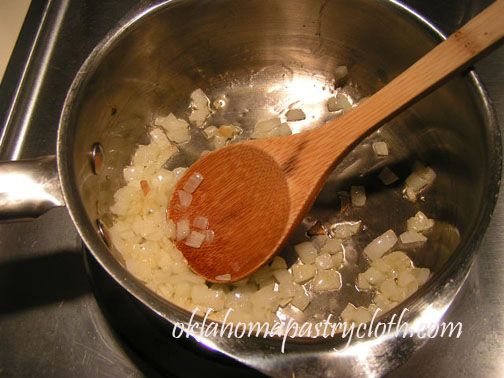
In a saucepan, saute onion in butter or olive oil until onions are transparent. I use olive oil.
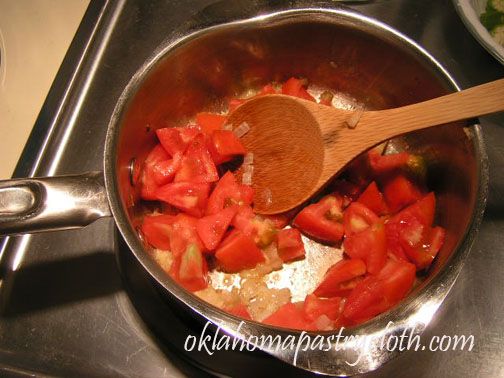
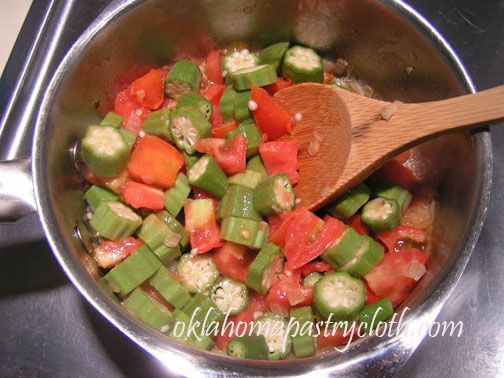
Add tomatoes and okra and stir until heated.
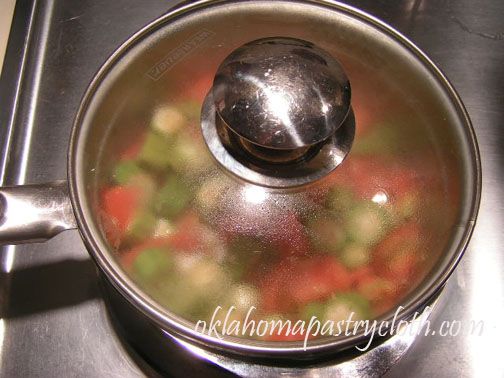
Lower heat and cover to simmer until okra is tender – about 15 minutes. (a little longer for larger amounts)
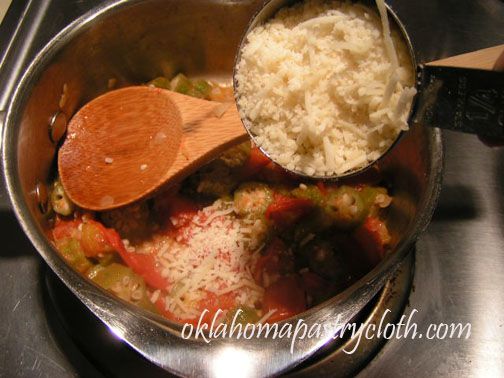
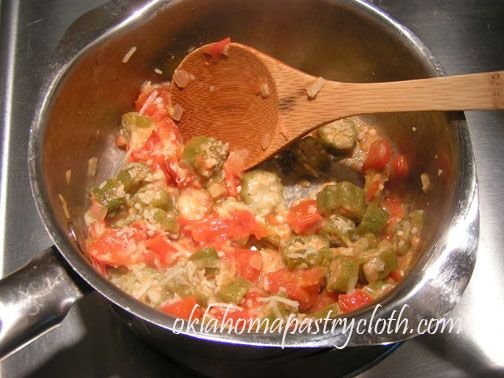
Add salt to taste and quickly toss with parmesan cheese to taste. Immediately remove from heat and serve as a side vegetable.
You Say Tomato; I say To-mah-to
Wednesday, July 29th, 2009
Many years ago, when I was in high school, my family, on their way to a summer in Maine, stopped to visit The Brotherhood of Christians also known as The Bruderhof, in Rifton, New York. At that time, any visitor joined in with the work that was the life sustaining neccessity required of every member of the community. The community produced and processed its own food, had its own school, and had a toy factory that manufactured very special and well-made wooden toys. The atmosphere was pleasant, friendly and quiet, but my sisters and I – looking forward to proms, graduation and meeting friends at the mall – were unsure about this way of life that was so alien to us. We were city girls who had no concept of being shut away from the world.
I truthfully have just scattered memories of the time spent at this community of The Bruderhof. Men and women dressed in the same style of dress, small apartments and a huge community ‘mess hall’ where all shared a meal at noon – a dish that we dubbed ‘Community Casserole’ that was a delicious combination of sauteed onions, celery, ground beef and rice, tea time, my father returning from a day in the toy factory all covered in sawdust and a farm of livestock and gardens that fascinated me, comprise the main of my recollections. However, spending a day peeling tomatoes for ketchup production stands out the most in my memory. I had never seen so many tomatoes in one place and I had never experienced peeling blanched tomatoes; skins slipping off of not-quite-soft whole tomatoes, juice running between fingers, across palms and down the forearm to drip, elbow as a spigot, onto the floor, into the lap or by happenstance into the bowl. To me, it was hillarious that I was even doing it and it has since become a family laugh. I’m pleased to remember that I threw myself into the work with gusto and considered that I was playing an important role in the continuing existence of this group of people…ok…so I’m pleased to remember it that way, but I’m pretty sure that I was not all that altruistic or enthusiastic.
It was the copper kettles that form my vision of the day the most. In the large room where we worked, a huge copper kettle over flames contained boiling water into which fresh tomatoes were dropped for an instant and then retrieved to put into ice water. These cooled tomatoes were transferred to us, peelings split and curling, ready for our knives to help continue the process of removing the skins and cores. The naked tomatoes were then sent to other large copper kettles where they were boiled down with spices and vinegar to make ketchup. It was my introduction to “canning” and left an indelible impression of heat, moisture and the overpowering smell of warm tomatoes. Those sensations revisit me every year as I now produce my own tomato products from the juicy, red jewels gathered from my garden. Who knew back then, that this city girl was a farm girl at heart?!
And so, with this post, I thought that I would invite you into my kitchen for a quick lesson on canning tomatoes. I have had a bumper crop this year with several “pounders” or larger, with an average size of nearly 3/4 pounds per tomato. I have had no hornworms or aphids and the typical fungus prone to Oklahoma seems to be in check. Blossom-end rot appeared at first, but was nipped in the bud (pun intended) by a healthy dose of lime and I have had no need for any kind of pest control at all. What a great year! I feel pressed to make use of every garden gift, wasting nothing, realizing that in Oklahoma next year may be a total bust!
Canning Quartered Tomatoes
Step 1: Wash fresh, firm tomatoes and leave whole. Bring water to a boil in a large stockpot and drop in tomatoes until full. Allow water to return to a boil, but watch for tomatoes as skins begin to split. Remove those tomatoes one by one and drop into iced water.
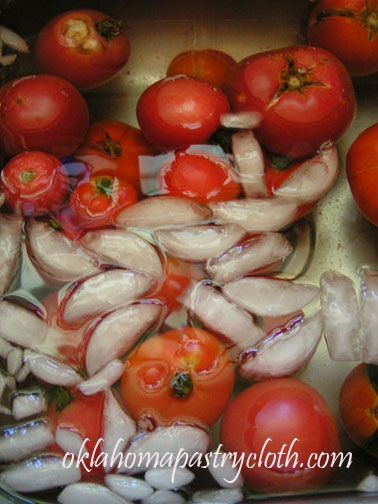
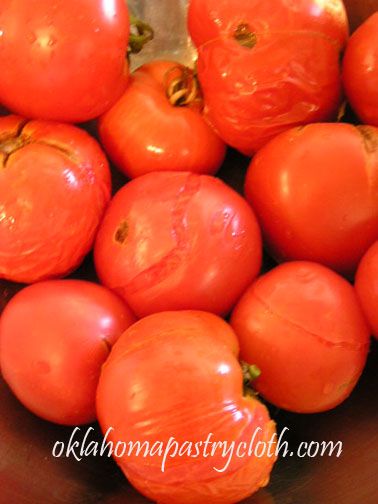
Step 2: In order to catch extra juice, over a large bowl remove the top center of each tomato with stem and lift peel off of the fruit. Place refuse into a second bowl. Quarter the tomatoes and place into the large bowl.

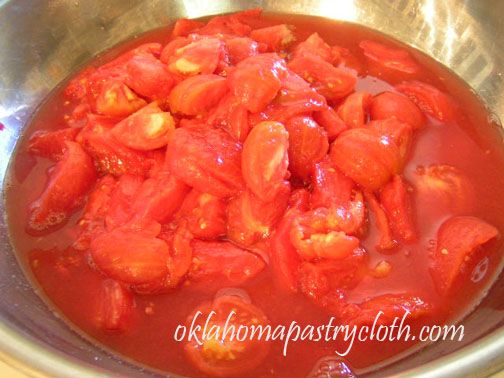
You can also juice the tomatoes and can just the juice if you like. My GreenLife Juicer makes quick work of the tomatoes.

Step 3: Place tomatoes and juice into canning jars to within 1/2″ of the top of the jar. Add 1/2 tsp. canning or uniodized salt to each pint or 1 tsp to each quart. Use a knife to gently move around the inside perimeter of the jar to remove any air bubbles.
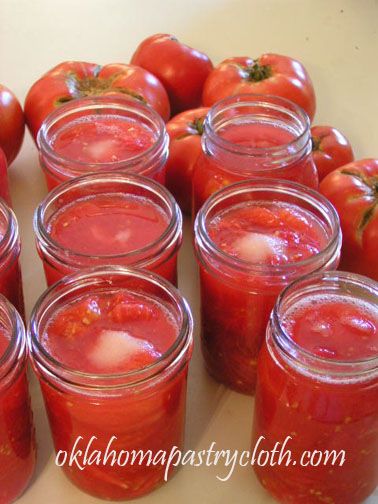

Step 4: With a damp cloth, wipe the tops of the jars to remove any juice, salt or pulp. Using lids that have been boiled and then kept warm in the water, place lids and rings onto jars and tighten, but not too tight.
Step 5: Because tomatoes are so acidic, they do not have to be pressure-canned like green beans and other low acid foods. The process used to can tomatoes is called ‘waterbath canning’ and is much less time consuming. A waterbath canner is simply a stainless or enameled large stock pot with a rack. Fill the canner about halfway with cool water and balance the rack on the top edge of the pot out of the water. The rack has handles that help to accomplish this. Place the jars into the rack and, when full, lower the rack of jars into the water. If the water level is not one inch over the tops of the jars, add more water. Bring the water to a boil and at the point of boiling, set a timer for 10 minutes. When the timer sounds, turn off the heat and using tongs to catch the handles and oven mits to protect hands, carefully lift the rack out of the boiling water and replace onto the top edge of the canner.
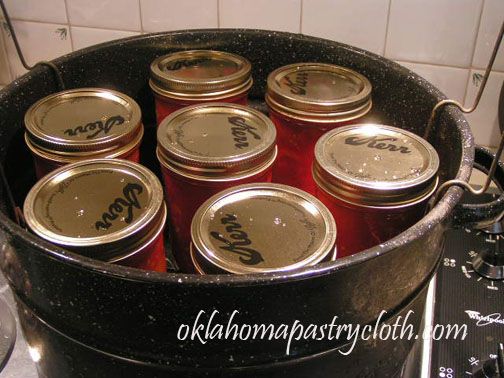

Step 6: Using canning tongs, remove jars from rack and place onto a kitchen towel on a counter to cool. Listen for the pingy pop that indicates that the vacuum has completed. Make sure that when the jars are cooled that the lids are flat with no give. If a lid has a bump in the center and pops when pressed, the jar did not seal and must be refrigerated or used immediately. Store vacuumed jars in pantry.
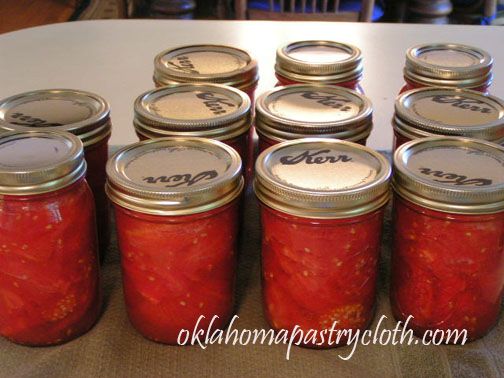
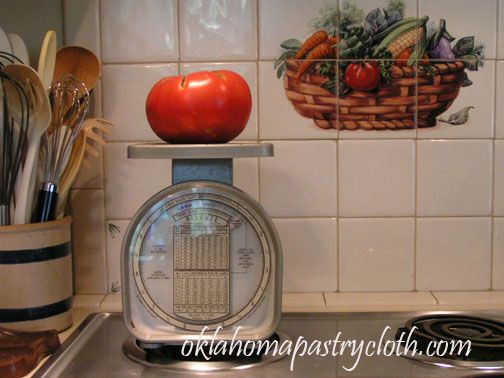
Step-by-Step to Canned Green Beans
Sunday, July 12th, 2009
I’ve been out in the garden gathering green beans and processing them for the winter. The plants are huge this year and the leaves are so large, there is no more distinguishing rows. I always plant Bush Blue Lake beans because they do not have to be staked and they produce stringless beans. This year has offered a bumper crop with the cool, early, summer temps and late arriving heat.
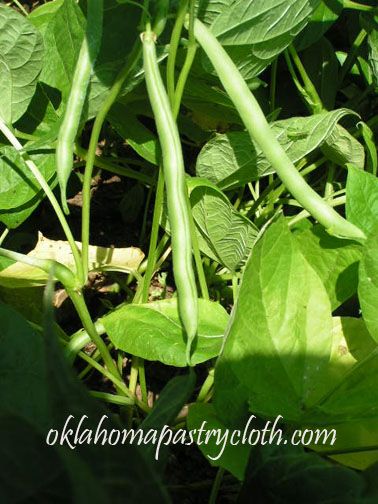
There is nothing more relaxing than sitting on the porch or in the den with a big bowl of beans in your lap, snapping them into another bowl. Pop – pop – pop! You get into a rhythm and your mind is soothed by the tempo. And that fresh smell!! Every so often, you just have to sample one of the sweet, juicy pods and you eat the whole thing raw! Can’t get any healthier than that!
Below, I have dedicated this post to a pictorial demonstration on canning green beans using the raw pack method. Because beans have a low acidity, all beans must be pressure canned at 10 lbs pressure for at least 65 minutes. A pressure canner with a guage or a weight is required. They can be purchased at hardware stores, WalMart and other similar stores and online.
Step 1: Wash green beans several times until all dirt, sand and old flowers are removed. Snap the pods to create uniformly, bite-sized pieces.
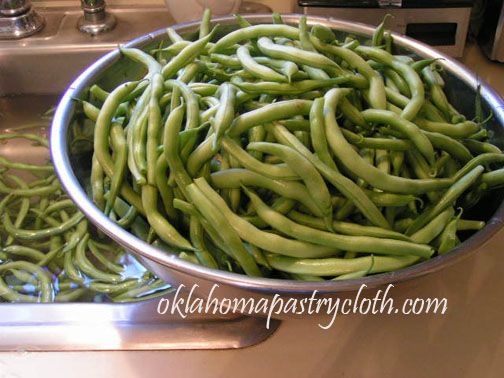
Step 2: Wash all jars and lids in very hot, soapy water and rinse in hot water. Dry.


Step 3: Put raw green beans into jars to within 1/2″ of the top of the jar and include 1/2 teaspoon of canning salt or uniodized salt if desired. Shake the jars as you put in the beans to make the beans gravitate to the bottom evenly.
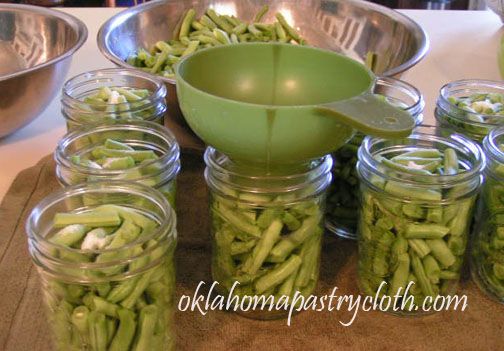
Step 4: Pour boiling water into each jar and over the beans to within 1/2″ of the top of each jar, leaving a 1/2″ head room. Run a plastic knife down the inside side of the jar to remove any air bubbles.
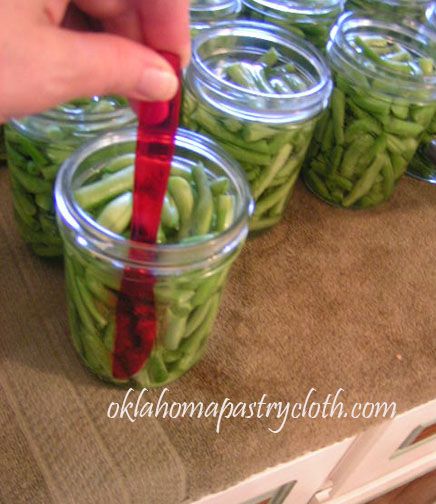
Step 5: Use a clean, damp cloth to wipe the edges of the jars. In a saucepan, cover the lids with water and bring them to a boil and remove from heat. Using tongs, carefully place the hot lids on the jars and put a ring in place. Tighten the rings just enough to call them tight. Too tight can cause problems!
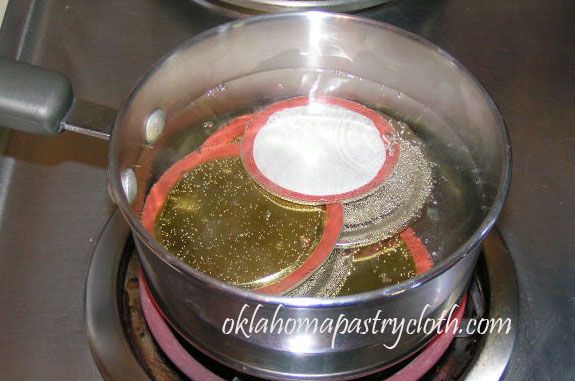
Step 6: Place about 2 inches of hot water in the canner and place the rack on the bottom. Fill the canner with jars according to the capacity of your particular canner. Tighten the cover and if a weight is used, put the weight in place. I like a canner that uses a weight because it is more accurate and does not need to be adjusted. If using a canner with a gauge, please follow the instructions that come with your canner. Turn the heat on high and wait until the weight begins to jiggle. At this point, reduce the heat to medium-high and monitor the weight, which should jiggle about every minute or so. Set the timer for 65-75 minutes and continue to monitor the pounds of pressure by listening to the weight.
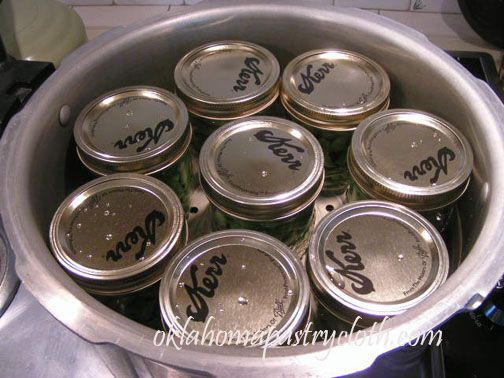
Step 7: When the beans are finished processing, turn off the heat and allow the canner to cool, unmoved, until the pressure has completely dissipated. It is very easy to get very severe steam burns if the canner has not been allowed to cool properly. When the canner has depressurized, remove the lid and carefully remove the jars, using jar tongs with one hand and holding the bottom of the jar with an oven mitt on the other. Soon, the pinging pop of jar lids completing a seal makes you smile because you know that you have been successful.
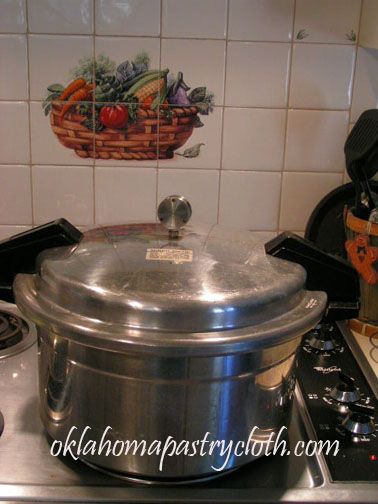
There is something very satisfying in neat rows of freshly canned produce in sparkling jars with golden lids. These are ready for the pantry and will be enjoyed for sure this winter!! I hope that you will take a stab at canning beans. If you don’t have your own garden, the local farmer’s market, health food store or grocery store has fresh beans that will work fine. Just make sure that they are crisp and not limp. Happy canning! It’s bean fun. 🙂
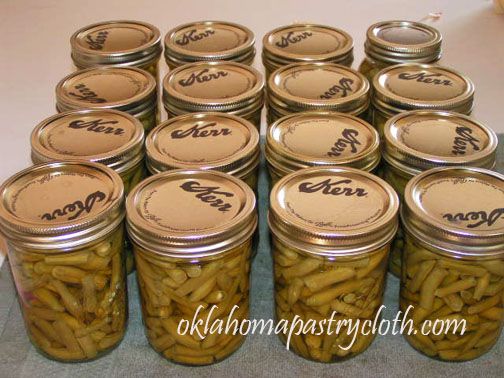
One Potato, Two Potato, Three Potato, Four…
Thursday, June 25th, 2009recipe posted below:
Oklahoma is blessed with two growing seasons. Vegetable gardeners nurse crops through the middle of July and then start over again on many Fall vegetables around the end of August. This year has been a little weird, as it was exceedingly cool and wet through May and the first part of June. Crops are a bit late this year, but now that they are coming in, they are coming in with a bang!
This morning, I gathered my shovel and wheel barrow, donned my garden gloves and headed out to dig potatoes. The sun was shining brightly at 6:45 a.m. and I knew that I had better get busy because the cool has gone and the 100 degree temps are now normally setting in. The air smelled fresh and clean and a heavy dew covered the ground. As I dug potatoes, I was treated to the various songs of a Mockingbird who was perched on top of our light pole. Mr. Mockingbird – the grand impersonator – ran through his repertoire – Bobwhite Quail, Phoebe, Cardinal, Crow, Whip-o-will, and his own personal warble. He’s so good, that one would swear that it was the real birds all calling out together.
The dirt smelled sweet as I dug to the side and beneath each plant, lifting a big clump full of potatoes. The dirt is as black and rich as can be, having been worked and mulched and composted these past 12 years. It started out as what is known in Oklahoma as “blow sand”. That is the bulk of our soil here in our area. But as horse manure, compost and mulch have been added every year, the sand has become the richest sandy loam.
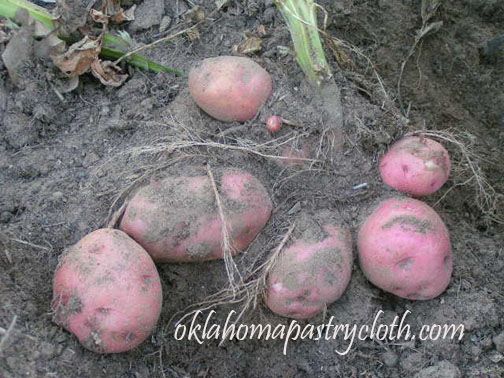
Potatoes are a miracle to me. From one seed potato that looks just like any that you would eat, as many as 4 plants can be had, by cutting the seed potato into pieces with “eyes” and then planting those. Each piece grows a plant and from each plant many of the tubers are produced. They invisibly enlarge underground, attached to runners from the plant. It is like digging for buried treasure and discovering gold – Yukon Golds to be exact. This year, I planted both yellow and the traditional red potatoes.
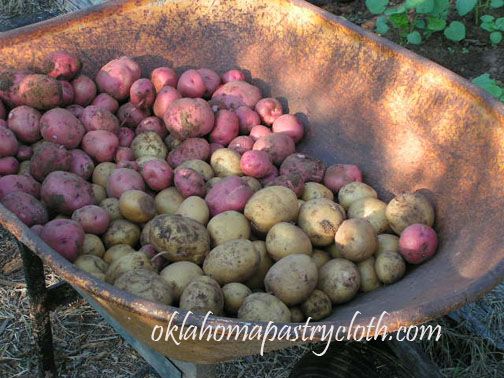
Every year, at our table, the first potatoes are made into Butter and Dilled Potatoes. You will find the recipe below. These are wonderful with roast beef or roast pork or roast chicken and are so fast and easy. They make wonderful leftovers too, because the flavors really permeate the potatoes after sitting in the frig. And if you are watching your cholesterol, I have included how to make them safely and you’ll never know the difference!! Thanks to the Irish for these nutritious tubers!!
Butter and Dilled Potatoes
5 large New Potatoes cut into large chunks
2 tbsp real butter (or 1 1/2 tbsp olive oil or canola oil + 1 tbsp Molly McButter for cholesterol watchers)
2-3 large sprigs of fresh dill or 1 1/2 tbsp dried dill weed
Salt to taste
In a large saucepan, cover potatoes with water and add butter, dill and salt. Bring to a boil and reduce heat to cook until potatoes are tender. Continue to cook until fluid is reduced by half. Serve while hot.
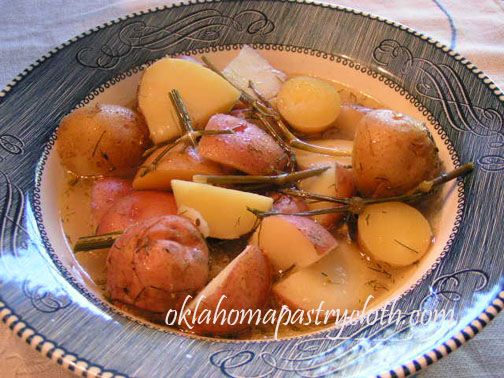

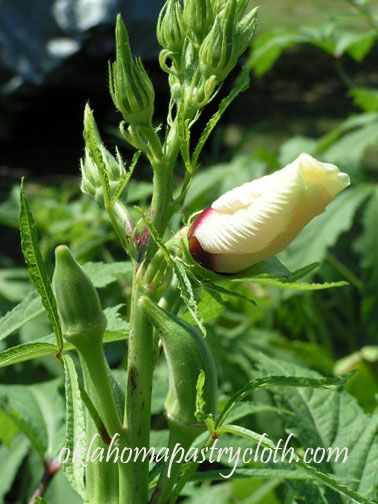
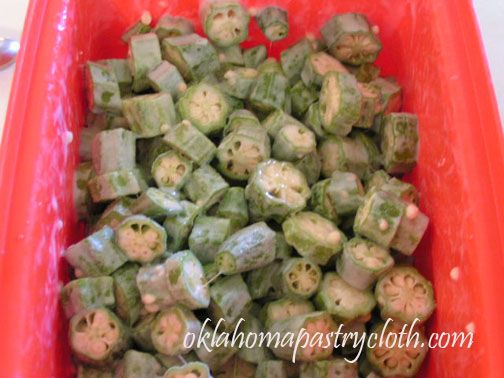


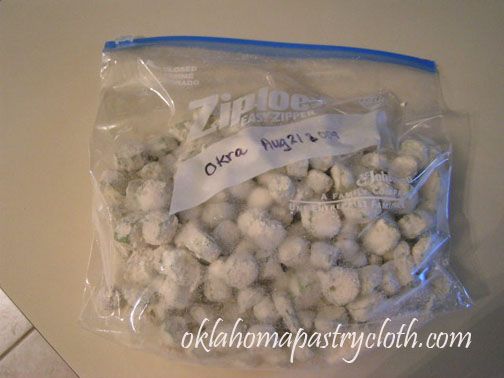
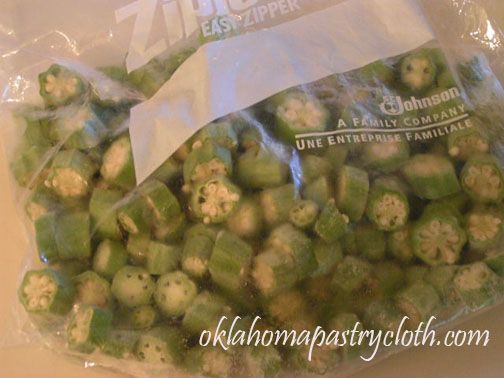
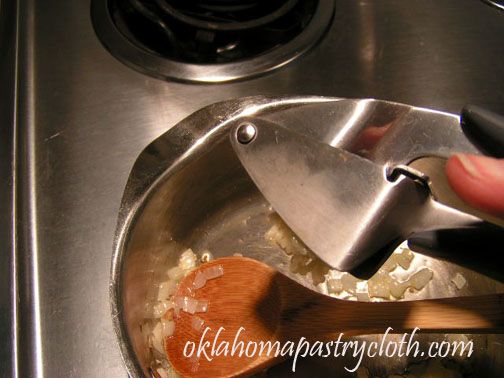
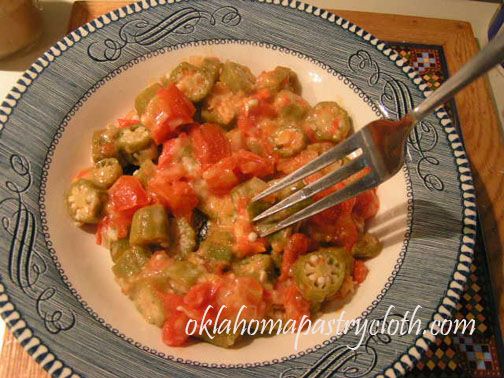
 Homestead Revival
Homestead Revival Paratus Familia
Paratus Familia Rural Revolution
Rural Revolution